1879 in paleontology
| |||
|---|---|---|---|
| +... |
Paleontology or palaeontology is the study of prehistoric life forms on Earth through the examination of plant and animal fossils.[1] This includes the study of body fossils, tracks (ichnites), burrows, cast-off parts, fossilised feces (coprolites), palynomorphs and chemical residues. Because humans have encountered fossils for millennia, paleontology has a long history both before and after becoming formalized as a science. This article records significant discoveries and events related to paleontology that occurred or were published in the year 1879.
Plants[edit]
Ferns[edit]
| Name | Novelty | Status | Authors | Age | Type locality | Location | Notes | Images |
|---|---|---|---|---|---|---|---|---|
|
Sp nov |
valid |
 |
Arthropods[edit]
Insects[edit]
| Name | Novelty | Status | Authors | Age | Type locality | Location | Notes | Images |
|---|---|---|---|---|---|---|---|---|
|
Sp nov |
valid |
 (1890 illustration) | ||||||
|
Sp nov |
valid |
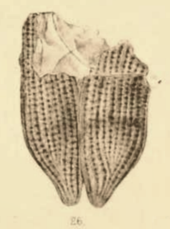 (1890 illustration) | ||||||
|
Sp nov |
valid |
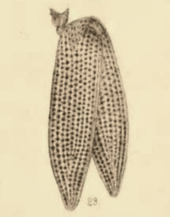 (1890 illustration) | ||||||
|
Sp nov |
valid |
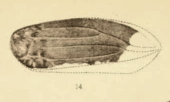 (1890 illustration) | ||||||
|
Sp nov |
valid |
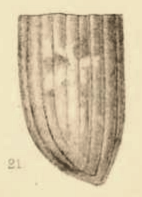 (1890 illustration) | ||||||
|
Sp nov |
valid |
 (1890 illustration) | ||||||
|
Sp nov |
jr synonym |
A gerrine water strider |
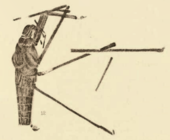 (1890 illustration) | |||||
|
Sp nov |
valid |
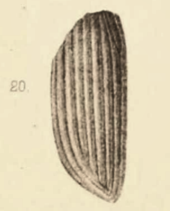 (1890 illustration) | ||||||
|
Sp nov |
Jr synonym |
A plecian marchfly |
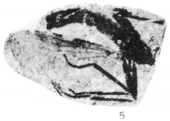 | |||||
|
Gen et sp nov |
Jr synonym |
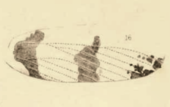 (1890 illustration) | ||||||
|
Sp nov |
valid |
 (1890 illustration) | ||||||
|
Sp nov |
valid |
 (1890 illustration) |
Ichthyosauromorpha[edit]
Ichthyosaurs[edit]
| Name | Novelty | Status | Authors | Age | Type locality | Location | Notes | Images |
|---|---|---|---|---|---|---|---|---|
|
Gen nov |
Junior homonym |
Marsh |
Late Jurassic (Oxfordian) |
Preoccupied by Sauranodon Jourdan, 1862; |
 |
Archosauromorphs[edit]
Newly named non-avian dinosaurs[edit]
| Name | Status | Authors | Age | Unit | Location | Notes | |
|---|---|---|---|---|---|---|---|
|
Valid |
middle Cretaceous (late Albian-early Cenomanian) |
A nodosaurid ankylosaur, a member of Struthiosaurinae. The type species is A. curtonotus. | |||||
|
Valid |
Late Jurassic (Kimmeridgian-Tithonian) |
An apatosaurine diplodocid. | |||||
|
Preoccupied. |
Late Jurassic (Kimmeridgian-Tithonian) |
Preoccupied by Uhler, 1864. Later renamed Camptosaurus. | |||||
|
Valid |
Late Jurassic (Kimmeridgian-Tithonian) |
A basal coelurosaur. The type species is Coelurus fragilis. | |||||
|
middle Cretaceous (late Albian-early Cenomanian) |
An dubious ornithopod. | ||||||
|
Valid |
Late Jurassic (Kimmeridgian-Tithonian) |
Junior subjective synonym of Allosaurus. The type species is Allosaurus lucaris Marsh, 1878. | |||||
|
middle Cretaceous (late Albian-early Cenomanian) |
A dubious ornithopod. The type species is S. macrocercus. | ||||||
|
Hulke |
early Cretaceous (Barremian) |
A dubious iguanodont. The type species is Vectisaurus valdensis. | |||||
Synapsids[edit]
"Pelycosaurians"[edit]
| Name | Novelty | Status | Authors | Age | Type locality | Location | Notes | Images |
|---|---|---|---|---|---|---|---|---|
|
Gen et comb nov |
Valid |
Fritsch |
A new genus for "Labyrinthodon" schwartzenbergii 1875. |
See also[edit]
References[edit]
- ^ Gini-Newman, Garfield; Graham, Elizabeth (2001). Echoes from the past: world history to the 16th century. Toronto: McGraw-Hill Ryerson Ltd. ISBN 9780070887398. OCLC 46769716.
- ^ Dawson, J. W. (1879). "Appendix B. List of tertiary plants in the southern part of British Columbia, with the description of a new species of Equisetum". Geological Survey of Canada, Report of Progress for. Vol. 1877–1878. Montreal, Quebec: Dawson Brothers. p. 187.
- ^ a b c d e f g h i j k l m Scudder, S. H (1879). "Appendix A. The fossil insects collected in 1877, by Mr. G.M. Dawson, in the interior of British Columbia". Geological Survey of Canada, Report of Progress for. 1877–1878: 175–185.
- ^ Handlirsch, A. (1910). "Canadian fossil Insects. 5. Insects from the Tertiary lake deposits of the southern interior of British Columbia, collected by Mr. Lawrence M. Lambe". Contributions to Canadian Palaeontology. 2 (3): 93–129.
- ^ Andersen, N.M. (1998). "Water striders from the Paleogene of Denmark and review of fossil record and evolution of semi aquatic bugs (Hemiptera Gerromorpha)". Biologiske Skrifter. 50: 1–157.
- ^ Scudder, S. H. (1890). "The Tertiary insects of North America". United States Geological Survey of the Territories, Washington: 615.
- ^ Szwedo, J.; Lefebvre, F. (2004). Fossil planthoppers of the world (Hemiptera: Fulgoromorpha). An annotated catalogue with notes on Hemiptera classification. Warszawa: Studio, 1. pp. 48–49. ISBN 83-912236-8-X.
- ^ a b c Seeley, H. G., 1879, On the Dinosauria of the Cambridge Greensand: Quarterly Journal of the Geological Society of London, v. 35, p. 591-636.
- ^ a b Marsh, O. C., 1879. Notice of New Jurassic Reptiles: American Journal of Science, 3rd series, v. 18, p. 501-505.
- ^ Marsh, O. C., 1879. Principal Characters of American Jurassic Dinosaurs. Part II: American Journal of Science, 3rd series, v. 17, p. 86-92.
- ^ Hulke, J. W., 1879, Vectisaurus valdensis, a new Wealden Dinosaur: Quarterly Journal of the Geological Society of London, v. 35, p. 421-424.
